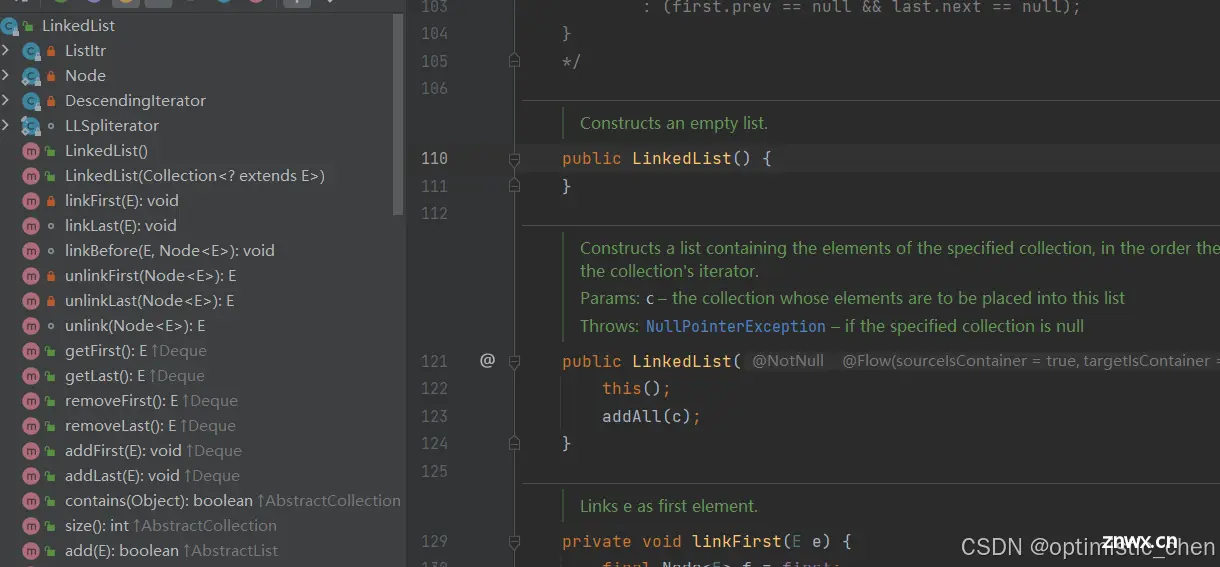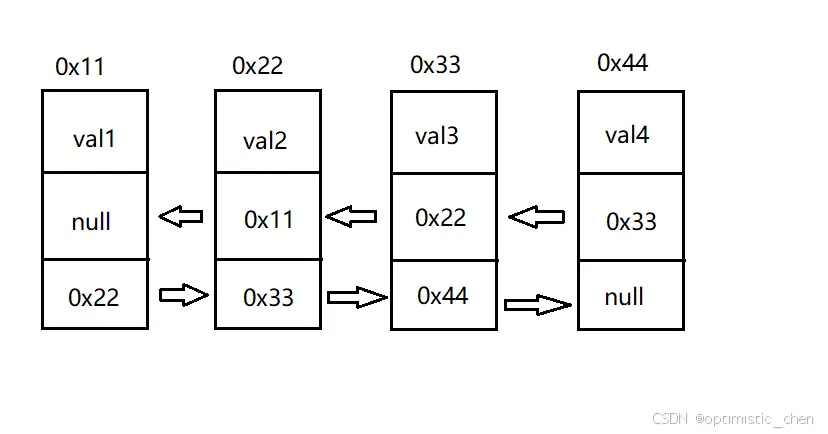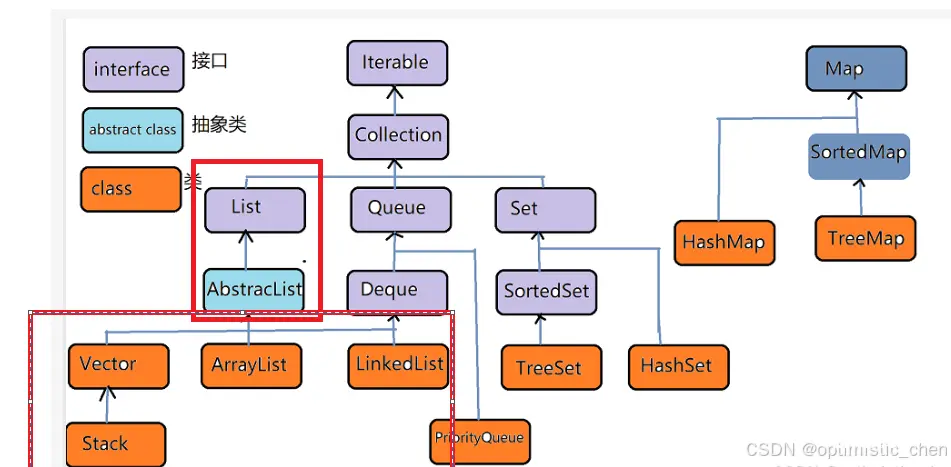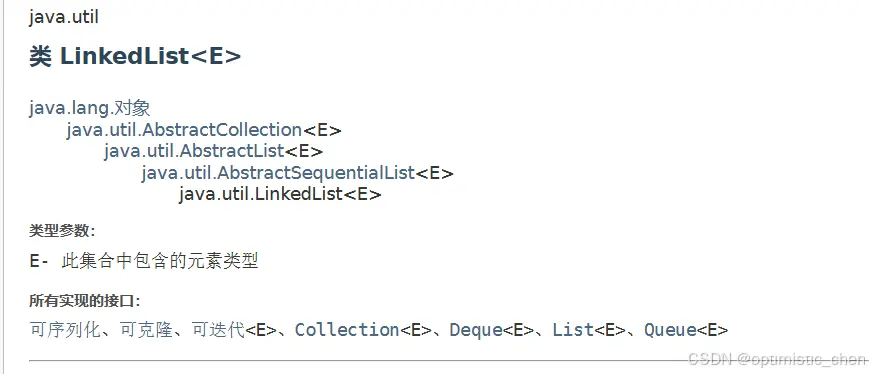【Java数据结构】---List(LinkedList)
optimistic_chen 2024-08-31 10:05:02 阅读 88
乐观学习,乐观生活,才能不断前进啊!!!
我的主页:optimistic_chen
我的专栏:c语言 ,Java
欢迎大家访问~
创作不易,大佬们点赞鼓励下吧~
文章目录
前言链表(MySingleList)具体功能代码
LinkedList简介LinkedList的模拟实现LinkedList的使用LinkedList的构造LinkedList的方法LinkedList的遍历
ArrayList和LinkeddList的区别完结
前言

上篇博客详细写了ArrayList的相关问题,包括上图(极其重要),我会在最近几篇博客中都有附上。
ArrayList的优点很明显,底层逻辑是一个数组,它通过下标去访问数据的速度非常快。但是在ArrayList任意位置插入或者删除元素时,就需要将后序元素整体往前或者往后搬移,时间复杂度为O(n),效率比较低
所以java集合框架中引入了LinkedList类,即链表结构。
链表(MySingleList)
链表,作为线性表的一种,它与顺序表截然相反:链表是一种物理存储结构 上 非连续存储结构, 数据元素的逻辑顺序是通过链表中的引用 链接次序实现的
之前C语言了解过这方面的知识C语言—链表专题,所以我们有一定的基础,我相信链表对于大家一定是熟悉的存在。我们先由易入难,先自己尝试一下单链表(MySingleList)的功能实现,为接下来的 LinkedList(无头双向链表) 打下基础.
接口
<code>public interface IList { -- -->
public void addFirst(int data);
public void addLast(int data);
public void addIndex(int index,int data);
public boolean contains(int key);
public void remove(int key);
public void removeAllKey(int key);
public int size();
public void clear();
public void display();
}
具体功能代码
头插法
@Override
public void addFirst(int data) {
ListNode node = new ListNode(data);
node.next=head;
head=node;
}
尾插法
@Override
public void addLast(int data) {
ListNode node =new ListNode(data);
if(head==null){
head = node;
return;
}
ListNode cur=head;
while(cur.next!=null){
cur= cur.next;
}
cur.next=node;
}
任意位置插入,第一个数据节点为0号下标
@Override
public void addIndex(int index, int data) {
int len=size();
if(index<0||index>len){
System.out.println("index位置不合法");
return;
}
if(index==0){
addFirst(data);
return;
}
if(index==len){
addLast(data);
return;
}
ListNode cur=head;
while(index-1!=0){
cur=cur.next;
index--;
}
ListNode node=new ListNode(data);
node.next= cur.next;
cur.next=node;
}
查找是否包含关键字key是否在单链表当中
@Override
public boolean contains(int key) {
ListNode cur=head;
while(cur!=null){
if(cur.val==key){
return true;
}
cur=cur.next;
}
return false;
}
删除第一次出现关键字为key的节点
@Override
public void remove(int key) {
if(head==null){
return;
}
if(head.val==key){
head=head.next;
return;
}
ListNode cur=findNodeOfKey(key);
if(cur==null){
return;
}
ListNode del= cur.next;
cur.next=del.next;
}
private ListNode findNodeOfKey(int key){
ListNode cur=head;
while(cur.next!=null) {
if (cur.next.val == key) {
return cur;
}
cur= cur.next;
}
return null;
}
删除所有值为key的节点
@Override
public void removeAllKey(int key) {
if(head==null){
return;
}
ListNode prev=head;
ListNode cur=head.next;
while(cur!=null){
if(cur.val==key){
prev.next=cur.next;
cur= cur.next;
}else{
prev=cur;
cur= cur.next;
}
if(head.val==key){
head=head.next;
return;
}
}
}
得到单链表的长度
@Override
public int size() {
int len=0;
ListNode cur=head;
while(cur!=null){
len++;
cur=cur.next;
}
return len;
}
清空链表
@Override
public void clear() {
ListNode cur=head;
while(cur!=null){
ListNode curN=cur.next;
cur.next=null;
cur=curN;
}
head=null;
}
LinkedList简介


LinkedList的底层是双向链表结构,由于链表没有将元素存储在连续的空间中,元素存储在单独的节点中,然后通过引用将节点连接起来了,因此在在任意位置插入或者删除元素时,不需要搬移元素,效率比较高。
总结:
LinkedList实现了List接口LinkedList的底层使用了双向链表LinkedList没有实现RandomAccess接口,因此LinkedList不支持随机访问LinkedList的任意位置插入和删除元素时效率比较高,时间复杂度为O(1)LinkedList比较适合任意位置插入的场景
LinkedList的模拟实现

头插法
<code>@Override
public void addFirst(int data) { -- -->
ListNode node=new ListNode(data);
if(head==null){
head=last=node;
}else{
node.next=head;
head.prev=node;
head=node;
}
}
尾插法
@Override
public void addLast(int data) {
ListNode node=new ListNode(data);
if(head==null){
head=last=node;
}else{
last.next=node;
node.prev=last;
last= last.next;
}
}
任意位置插入,第一个数据节点为0号下标
@Override
public void addIndex(int index, int data) {
int len=size();
if(index<0||index>len){
return;
}
if(index==0){
addFirst(data);
return;
}
if(index==len){
addLast(data);
return;
}
ListNode cur=findIndex(index);
ListNode node=new ListNode(data);
node.next=cur;
cur.prev.next=node;
node.prev=cur.prev;
cur.next=node;
}
private ListNode findIndex(int index){
ListNode cur=head;
while(index!=0){
cur= cur.next;
index--;
}
return cur;
}
查找是否包含关键字key是否在链表当中
@Override
public boolean contains(int key) {
ListNode cur=head;
int count=0;
while(cur!=null){
if(cur.val==key) {
return true;
}
cur= cur.next;
}
return false;
}
删除第一次出现关键字为key的节点
@Override
public void remove(int key) {
ListNode cur=head;
while(cur!=null){
//开始删除
if(cur.val==key){
//有可能是头节点
if(cur==head){
head = head.next;
if(head!=null){
head.prev=null;
}
}else{
cur.prev.next= cur.next;
if(cur.next==null){
//有可能是尾节点
last= last.prev;
}else{
cur.next.prev= cur.prev;
}
}
return;
}else{
cur = cur.next;
}
}
}
删除所有值为key的节点
@Override
public void removeAllKey(int key) {
ListNode cur=head;
while(cur!=null){
//开始删除
if(cur.val==key){
//有可能是头节点
if(cur==head){
head = head.next;
if(head!=null){
head.prev=null;
}
}else{
cur.prev.next= cur.next;
if(cur.next==null){
//有可能是尾节点
last= last.prev;
}else{
cur.next.prev= cur.prev;
}
}
}else{
cur = cur.next;
}
}
}
LinkedList的使用
前面我们自主实现了LinkedList的各种方法,只是为了大家更好的理解和学习,以后做题可能会运用到类似的想法或思路,可以更加高效的完成题目,平时也可以直接使用LinkedList下的方法。如下图:

LinkedList的构造

<code>public static void main(String[] args) { -- -->
List<Integer> list1=new LinkedList<Integer>();
LinkedList<Integer> list2 = new LinkedList<Integer>();
//使用ArrayList构造LinkedList
List<String> list3=new ArrayList<>();
List<String> list4=new LinkedList<>(list3);
}
为什么可以有的构造可以用List,有的用LinkedList,甚至出现了ArrayList?一切都是这张贯穿整个数据结构的图。

LinkedList的方法
<code>public static void main(String[] args) { -- -->
LinkedList<Integer> list = new LinkedList<>();
list.add(1); // add(): 表示尾插
list.add(2);
list.add(3);
list.add(4);
list.add(5);
list.add(6);
list.add(7);
System.out.println(list.size());
System.out.println(list);
// subList(from, to): 用list中[from, to)之间的元素构造一个新的LinkedList返回
List<Integer> list2 = list.subList(0, 3);
System.out.println(list);
System.out.println(list2);
list.clear(); // 将list中元素清空
System.out.println(list.size());
}
LinkedList的遍历
之前ArrayList博客【Java数据结构】—List(ArrayList) 讲过线性表的遍历,这次补充一下…
public static void main(String[] args) {
LinkedList<Integer> list = new LinkedList<>();
list.add(1); // add(): 表示尾插
list.add(2);
list.add(3);
list.add(4);
list.add(5);
list.add(6);
list.add(7);
System.out.println(list.size());
// 使用反向迭代器---反向遍历
ListIterator<Integer> it = list.listIterator(list.size());
while (it.hasPrevious()){
System.out.print(it.previous() +" ");
}
}
ArrayList和LinkeddList的区别
| 不同 | ArrayList | LinkedList |
|---|---|---|
| 存储空间 | 物理上一定连续 | 逻辑上连续,但物理上不一定连续 |
| 随机访问 | 支持O(1) | 不支持O(n) |
| 头插 | 空间不够时扩容 | 不存在容量的概念 |
| 运用场景 | 元素高效存储+频繁访问 | 频繁任意位置的插入和删除 |
完结
好了,到这里Java语法部分就已经结束了~
如果这个系列博客对你有帮助的话,可以点一个免费的赞并收藏起来哟~
可以点点关注,避免找不到我~ ,我的主页:optimistic_chen
我们下期不见不散~~Java
下期预告: 【Java数据结构】- - - List
声明
本文内容仅代表作者观点,或转载于其他网站,本站不以此文作为商业用途
如有涉及侵权,请联系本站进行删除
转载本站原创文章,请注明来源及作者。
